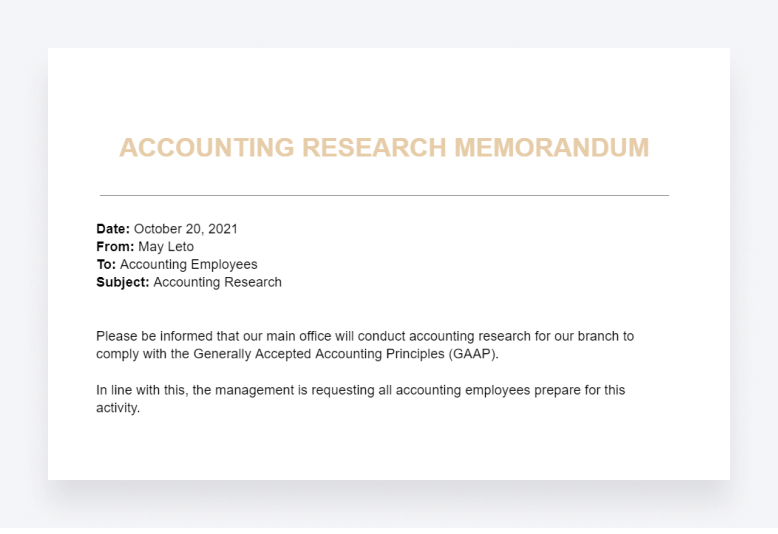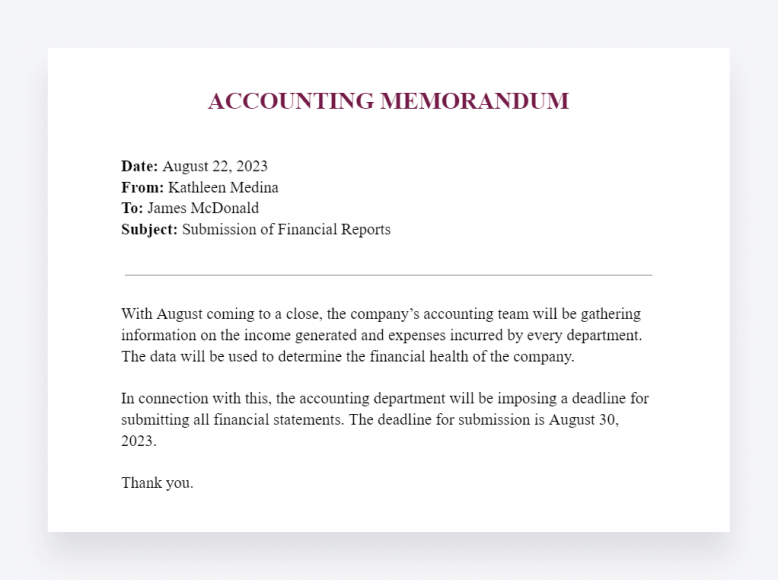
With accounting revolving around complex compliance and operations data, clear documentation and communication of policies, procedures and regulations is imperative — for accounting teams and clients alike. However, crafting such material can prove challenging.
Even routine accounting matters translate confusingly to broader audiences when not framed appropriately. This makes drafting concise, professional memos nothing short of an essential skill for seamlessly running an organization.
This article equips accountants with accessible best practices for producing credible, relatable memos. Expect digestible guidance on the optimal structure, content considerations and writing approaches, with downloadable templates and step-by-step instructions.
What is an accounting memo?
An accounting memo, or accounting memorandum, is a written business communication tool used to inform, notify or advise professional services for firm staff or clients on essential accounting, tax and finance issues. Memos help document important updates, events or changes related to policies, regulations, procedures and more.
When to use an accounting memo?
Accounting memoranda serve a vital purpose across various scenarios encountered by professional services firms. Common situations where a memo offers an optimal communication format include:
- Notifying clients or staff of major policy or procedure changes related to billing rates, payment terms, service offerings or compliance protocols
- Introducing new technologies or software to teams across service lines, detailing timelines for training sessions and firmwide implementation
- Updating personnel on upcoming events such as office relocations or renovations, external audits, training seminars or staffing additions
In all of the above cases, accounting memos provide credible, durable notifications compared to verbal discussions or emails. As long as messages remain clear, concise and actionable, accounting memos boost transparency and facilitate seamless accounting operations enterprise-wide.
For more tips on streamlining accounting workflows, refer to this comprehensive guide on accounting process automation.Components of an effective accounting memo
When crafting an accounting memorandum, including certain standard sections allows readers to easily extract key details. Though formats may vary across firms, most quality accounting memos contain the following core pieces:
- Header: quick context upfront, including date, sender/recipient names and contact information, and carbon copy (CC) listings
- Subject line: a brief, descriptive subject line capturing readers’ attention at a glance, similar to an email
- Introduction: a concise opening paragraph explaining the purpose and outlining main points covered to quickly align recipients on priorities
- Background: optional context about related events leading up to memo issuance if relevant to provide perspective
- Body: the main part of the document providing commentary, analysis, instructions and details readers need to know regarding the stated subject
- Conclusion: a closing paragraph with major takeaways or action items requiring attention that readers can easily refer to when needed
- Attachments: supplementary files such as updated policy PDFs, graphics illustrating new workflows or tools and templates affected by memo guidance
- Signatures: a sign-off area with signatures of approvers, validating the memo’s credibility
How to write an accounting memo
When creating an accounting memo, following a clear process ensures the document is professional, accurate and effective at clearly communicating essential information to the intended recipients. Here are the seven primary stages:
1. Research and preparation
- Thoroughly research the accounting standards, regulations, policies, etc. related to the memo topic
- Consult with stakeholders involved to understand needs and gather input
- Decide on your key objectives and audience for the memo
2. Outline key points
- Consider what background information readers will need to understand the context
- Make a detailed outline organizing the topics, details, examples and attachments to cover
- Structure the outline logically, starting with an introduction and ending with main takeaways
3. Draft the memo
- Follow the standard memo format with clear headings and sections
- Draft concise paragraphs for each outlined point, stating details precisely
- Use bullets and lists to make complex information digestible
- Incorporate relevant examples, data and graphics to reinforce points
4. Refine the content
- Review and refine the draft for clarity, accuracy, logical flow and professional tone
- Check that concepts and procedures are explained thoroughly, defining any jargon
5. Finalize the memo
- Proofread thoroughly for any errors in grammar, spelling or facts
- Obtain approvals and signatures from key parties
6. Distribute the memo
- Send the finalized memo to all appropriate recipients
- Attach any supplementary files, such as policy documents, visual aids, spreadsheets, etc.
7. Follow up
- Reiterate major action items or deadlines needed from recipients
- Be available to promptly answer any recipient questions that arise
- Set calendar reminders to revisit memo topics, policies and updates in future
Downloadable accounting memo template
As a starting point, we have created a customizable accounting memo template below for your reference. Feel free to adapt it to suit your firm’s communication needs and tailor the content to your specific scenario.
__________________________________________
Date: [Month, Day, Year]
From: [Sender’s name and title]
To: [Recipient name(s) and title(s)]
Cc: [Name and title of anyone copied]
Subject: [Brief description of memo purpose and contents]
This memo is intended to notify staff of [high-level summary of key announcement, policy changes, procedure updates, etc.] See below for additional details and relevant attachments.
[Optional paragraph summarizing events leading up to memo issuance]
Policies/Procedures
[Details on new protocols, deliverables required of teams/staff, etc.]
Deadlines
[Key dates of changes being implemented]
Wrapping up
To recap, the key points for staff to know regarding this [policy, procedure, milestone, etc.] update are:
- [Main takeaways and/or action items]
- [Main takeaways and/or action items]
- [Main takeaways and/or action items]
Please direct any further questions or concerns to [appropriate contact person and details]. We appreciate your support in enabling a seamless transition.
Attachments
[List any supplementary files/documents provided]
Approved by:
[Signature]
[Your name]
[Your title, your company name]
[Contact information]
__________________________________________
To access a free, downloadable template copy, visit the link below. Select “File > Download” to save the template to your preferred location on your local device or network.
Examples of accounting memos
1. Accounting research memorandum
An accounting research memo documents and communicates requested research activities to comply with GAAP or other regulations.

The provided memo notifies employees of an upcoming accounting research visit to ensure GAAP compliance. While concise, providing additional context could improve comprehension and urgency around the preparation required.
Pros:
- Quickly alerts staff to significant research compliance check-in
- Signals expectations around employee readiness and policy knowledge
Limitations to improve:
- Lacks specifics on which GAAP principles/standards will be examined
- Does not indicate research visit date/duration
- Fails to articulate methodology or scope of practices
- Does not specify nature of employee “preparations” anticipated
Enhanced research memos might provide resources for employees to brush up on GAAP in areas tied to their direct responsibilities. Citing narrower focus areas allows personalized advance review. Explicit preparation guidance could include refreshing documentation, quantifying success metrics, or practicing discussing standard inquiries.
Overall, this memo has the right foundational objective but risks missing the mark on properly equipping staff. More detailed, targeted communication around accounting compliance assessments means less ambiguity and disruption when audits commence.
2. Accounting memorandum

This memo serves as an official notice that as the fiscal month closes, accounting needs timely financial statements from each business unit to synthesize company-wide profit and loss statements. A firm submission deadline reinforces urgency.
Pros:
- Official record of notice for end-of-month financial reporting tasks
- Concise and direct statement of expectations
- Reasonable amount of lead time given for deadline
Limitations to improve:
- No specifics on precisely what reports are needed or templates to use
- No guidance offered on where or how to submit reports
- No indication of scope or metrics reports should cover
- No contact or resources provided for questions
While brief and rightfully direct in setting expectations, additional context could reduce ambiguity. Nonetheless, this accounting memo provides helpful documentation around initial notice for common periodic financial reporting tasks.
3. Accounting policy memorandum

This memo serves to provide formal notice of an imminent accounting policy change dictating the use of new prescribed templates for crafting financial statements. A clear, effective date sets expectations around timing.
Pros:
- Concise statement about mandatory new format
- Establishes accountability with compliance implications stated
Limitations to improve:
- No context for rationale/benefits of format change
- No clarity around where to access the new templates
- No details provided on the submission/filing process
- No transitional guidance or resources offered
- No contact for questions/concerns
While the memo directly sets a vital organizational expectation, additional details would significantly improve comprehension and facilitate better adoption. Extended messaging around “why” often boosts employee buy-in. Logistical specifics on template access, submission procedures, transitional support, etc. also reduce pushback stemming from uncertainty.
Writing tips for clear accounting memos
Beyond following standard formatting, when writing a memorandum for accounting, you can employ various techniques to enhance message clarity. Consider the following advice:
1. Use visual formatting
Incorporate section headers, lists, highlights and ample paragraph spaces to maximize skimmability.
2. Simplify complex concepts
Break down intricate policies, sophisticated methodologies or elaborate protocols using digestible language and easy-to-follow flowcharts.
3. Limit firm-specific jargon
Explain acronyms, technical concepts or niche methodologies unlikely to resonate with certain personnel.
4. Cite data selectively
While they strengthen arguments, too much complex numerical data can turn off readers. To emphasize key points, only use figures that directly relate to them.
Conclusion
When accounting goals, visions or industry shifts seem ambiguous amidst ever-changing commercial landscapes, clear communication is critical. Following the strategies outlined in this article, accounting teams can craft polished, professional memos that successfully inform personnel, leadership and clients on key issues.
With great care and forethought invested in planning, research, framing and editorial refinement, accounting professionals can utilize memos’ authoritative qualities to strategically inform, educate and guide stakeholders. Well-crafted memos that resonate with audiences have the potential to inspire engagement, transparency and a unified direction across entire companies.

Thank you! The eBook has been sent to your email. Enjoy your copy.
There was an error processing your request. Please try again later.
Looking to boost your firm's profitability and efficiency?
Download our eBook to get the answers



